Are you struggling with student loan debt?
Or maybe you’re not struggling to pay your loans; you simply want them GONE.
Student loan forgiveness may be your answer.
According to Experian, the average 2019 college graduate with student loan debt had a balance of $35,359 in student loans. That’s a lot of debt for anyone, but especially for someone who’s barely into their twenties.
Fortunately, if you’re carrying student loan debt, you may have options. Student loan forgiveness is a real possibility for those who are eligible.
We’re sharing this comprehensive guide on how to determine if you’re eligible for student loan forgiveness, and what programs offer loan forgiveness. See if you can find a way to lighten your student loan burden via one of the following programs.

Breaking News Alert: Get A 60-Day Forbearance And Interest-Free Loan Period Due To Coronavirus!!
There have been some announcements made in regards to federal student loans, due to the coronavirus.
No Interest On Federal Loans For 60 Days
The federal government has announced that federal student loan holders will pay interest of ZERO percent on all student loan balances for the next 60 days AND get two full payments waived as well.
Starting March 13, 2020 your federal student loan balances were set to a zero percent (0%) interest rate for 60 days.
You do not have to take any action to take advantage of this benefit: it’s already done!
Administrative Forbearance – No Payments For 60 Days
In addition to zero interest, you have the option to have your federal student loan payments waived for 60 days.
In order to take advantage of this benefit, you need to contact your federal student loan service and request an administrative forbearance.
Remember that these temporary benefits apply only to federal student loans and not private student loans. Good luck!
Read more about the COVID-19 student loan relief plans here.
UPDATE: As of August 8th, 2020 President Trump directed the Secretary to suspend loan payments, stop collections and waive interest on Education Department held student loans until 12/31/2020. For full details, see this page.
Top Ways To Get Your Student Loans Forgiven
There are several ways in which people become eligible to have their student loans forgiven. Look through the details of the following programs. See if you are already eligible for student loan forgiveness via one of these programs.
Or if you can become eligible by switching careers or forging through some other path to earn loan forgiveness.
Public Service Loan Forgiveness Program (PSLF)
The Public Service Loan Forgiveness program was created in 2007 to help people who work full time in public service jobs get relief from their student loans. Here’s a little about the program and how it works.
In order to qualify for the PSLF program, you’ll need to work full-time in a qualified job position with either the local, state or federal government. Or you’ll need to work for a 501c3 non-profit or other qualified non-profit organization.
Some types of jobs that might qualify under the PSLF program could include:
- Teachers of public schools or 501c3 private schools
- Any employee of the government
- Military and Department of Defense jobs
- Government-sponsored firefighters and police officers
- Employees of non-profit organizations such as churches and charities
Other types of jobs could qualify as well.
Note that you must make 10 years of full, on-time payments before you can qualify for PSLF program loan relief. Also, only federal direct loans (subsidized and unsubsidized Stafford loans, PLUS loans, and federal direct consolidation loans) qualify for the program; other types of loans do not.
Apply for the Public Service Loan Forgiveness program.
Have you been denied for your PSLF application? See if you qualify for TEPSLF, a temporary expanded program of PSLF.
Teacher Loan Forgiveness Program
Under the Teacher Loan Forgiveness Program, you might qualify for loan forgiveness of up to $17,500 if you meet the required guidelines.
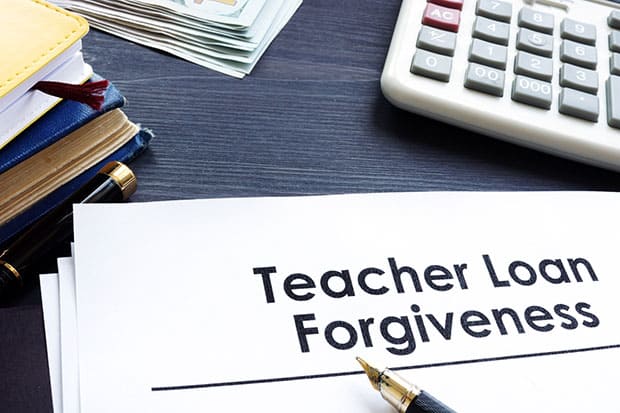
Part of the guidelines state that you need to teach for five full and consecutive academic years in a low-income school or educational service agency.
Note that you can qualify for both the Teacher Loan Forgiveness Program and the PSLF program. However, there are caveats to qualifying for both, such as the fact that your required service as a teacher has to be non-concurrent with the 120-month repayment requirement PSLF has.
Learn more about the Teacher Loan Forgiveness Program here.
State-Sponsored Forgiveness Programs
Nearly every state in the U.S., along with the District of Columbia, has some type of state-based student loan forgiveness program. There is too much information to discuss state-sponsored forgiveness programs here.
However, most of them relate to public service jobs. Simply do an internet search for your state along with “student loan forgiveness programs” to find state-specific information on student loan forgiveness.
Military Student Loan Forgiveness And Assistance Programs
There are several student loan assistance programs based on when you were in the military, which branches you are or were in and so on. Likely the most all-encompassing program is the Military College Loan Repayment Program (CLRP).
This program benefits college students who have already accumulated student loan debt and are willing to enter active duty military service. Other military personnel may be eligible for this program as well.
You must have a Federal Direct Loan, Federal Family Education Loan or Perkins Loan in order to qualify for this program, and the loan must not be in default.
There are other qualifications that must be met as well, and the repayment/forgiveness amount you qualify for will vary based on the type of military service you choose.
To learn more about the Military CLRP go here.
SEMA Loan Forgiveness
SEMA, which stands for Specialty Equipment Market Association, is an organization that serves the motor vehicle aftermarket. They have a loan forgiveness program--and a scholarship program--for individuals who start a career in the automotive industry.
In order to qualify, you need to work for a company that is a member of SEMA. There are additional requirements as well, but you could earn up to $5,000 toward your schooling. Visit the SEMA website scholarship page for more information.
Veterinarian Loan Forgiveness Program
The USDA has a loan forgiveness program for veterinarians who work in a designated USDA National Institute of Food and Agriculture veterinarian-shortage situation for at least three years.
The Veterinary Medicine Loan Repayment Program will pay up to $25,000 of your student loans each year if you meet the program’s qualifications. The areas where shortage situations apply changes each year.
To find out more information use the link above, where you’ll learn about qualification requirements and how to apply.
Indian Health Service Loan Repayment Program
This program will repay up to $20,000 of your student loans per year in exchange for an initial two-year service obligation to practice full time at an Indian health program site.
Qualifying applicants must work in specific health professions and be willing to work for an initial two-year period in a qualifying American Indian or Alaskan Native health care facility.
For more information on this program, check out this government website page on the Indian Health Service Loan Repayment Program.
Other Medical Professional Loan Repayment Programs
Aside from the PSLF program and the Indian Health Service Loan Repayment Program, there are other loan forgiveness programs for medical professionals such as nurses.
To learn more about currently available loan forgiveness programs for health and medical professionals, check out this article from Edvisors.
Attorney Loan Repayment Programs
Here are two popular loan repayment programs that apply to attorneys.
The first is called the Attorney Student Loan Repayment Program. This program can benefit those who commit to working for the Department of Justice for a minimum three-year period. You can learn more about the program by visiting the Attorney Student Loan Repayment Program webpage.
The second program is called the John R. Justice student loan repayment program. This program provides loan repayment for attorneys who work as state public defenders and state public prosecutors for a minimum of three years. Learn more about this program here.
Employer-Based Loan Repayment Programs
There are a few companies that will offer to repay some of your student loans if you meet the requirements for working for their companies. Although many companies offer tuition reimbursement if you go to school while working there, some are adding loan repayment programs.
You’re most likely to find these types of programs if you work for a larger company. Some examples of companies that offer loan repayment programs include:
- The federal government
- Aetna
- PriceWaterhouseCoopers
- SoFi
- Fidelity
Check with your company’s Human Resources department to see if your company has a loan repayment program.
Perkins Loan Forgiveness
If you have a federal Perkins loan, you can get up to 100% of it cancelled if you qualify. Perkins loan cancellation is based on eligible employment or volunteer services and the length of time you served in those positions.
Some of the career or volunteer positions that can qualify you for Perkins loan cancellation include:
- Teacher, librarian or guidance counselor who has direct services related to classroom teaching for the k-12 students (administration jobs aren’t eligible)
- Special education teachers
- Early childhood education provider
- Firefighter
- Law enforcement officer
- Military service
- Public defender
- Nurse or medical technician
- Faculty member of a tribal college or university
- AmeriCorps or Peace Corps volunteer
Note that there are other qualifications that may be required along with a job title in order for you to get your Perkins loan cancelled. For instance, you may be required to be considered a full-time employee.
In addition to Perkins loan cancellation, you may also qualify for a Perkins loan complete discharge if you meet one of the following criteria:
- Bankruptcy
- Death
- School closure
- Service connected disability (for veterans)
- Total and permanent disability
- Spouse of a victim of the events of 9/11
Note that the bankruptcy discharge approval is rare. It’s only applicable if proof of undue hardship from the payments is shown.
Also, it’s important to note as well that certain job eligibility requirements include specific education requirements to be met as well.
To learn more about Perkins Loan cancellation and discharge, check out the government’s student aid website page on the subject.
Income-Driven Repayment Plans
The government currently has four income-driven repayment plans in place. With income-driven repayment plans, your payment is typically based on the amount of your discretionary income.
Once you make payments for a specified number of years, any remaining student loan balances are completely forgiven. Obviously, these types of programs work best for people with lower incomes or higher monthly expenses.
Here’s a summary of each of the currently available income-driven plans.
Income-Based Repayment (IBR) Plan
The Income-Based Repayment Plan has different rules for loans taken out before July 1, 2014 and loans taken out after July 1, 2014.
If you’ve taken out your loans before this date, you’ll generally be required to make payments equal to 15 percent of your discretionary income. However, the payments will not be more than the 10-year standard repayment plan amount, even if that amount is less than 15 percent of your discretionary income.
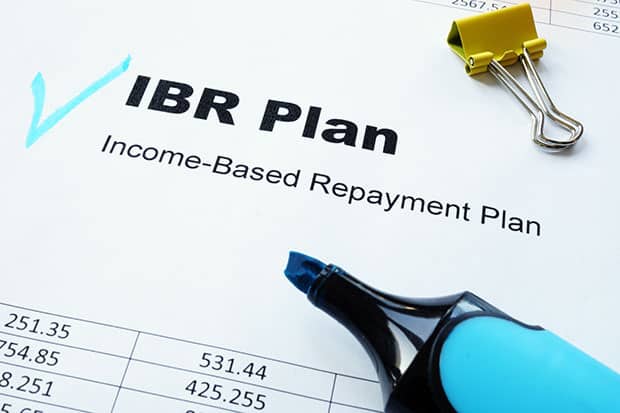
If you took out your loans AFTER July 1, 2014, you will typically be required to make payments equal to 10 percent of your discretionary income. Again, the payments will not be more than they would under the 10-year standard repayment plan amount, even if that amount is less than 10 percent of your discretionary income.
Note from the federal government on “new loan” qualifications:
“*For the IBR Plan, you're considered a new borrower on or after July 1, 2014, if you had no outstanding balance on a William D. Ford Federal Direct Loan (Direct Loan) Program loan or Federal Family Education Loan (FFEL) Program loan when you received a Direct Loan on or after July 1, 2014. (Because no new FFEL Program loans have been made since June 30, 2010, only Direct Loan borrowers can qualify as new borrowers on or after July 1, 2014.)”
Keep in mind that your payment terms for the IBR plan are as follows:
- You’ll pay for 20 years if you’re a new borrower after July 1, 2014
- You’ll pay for 25 years if you’re NOT a new borrower after July 1, 2014
After your payment term is up, any remaining balances on your student loans will be completely forgiven.
PAYE Program
The PAYE plan is similar to the IBR program, with the exception that only certain loans going back to 2007 qualify.
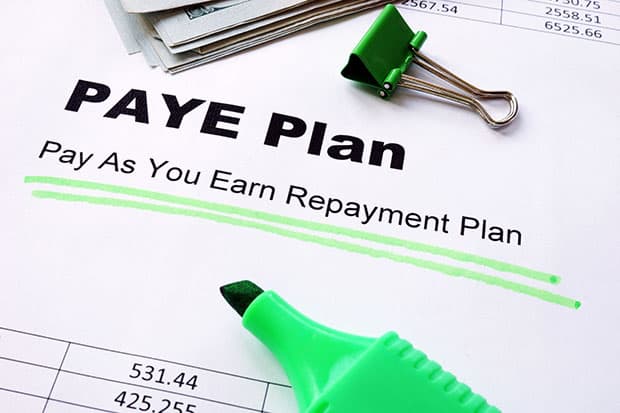
If you qualify for the PAYE program, you’ll generally be required to pay a payment amount equal to 10 percent of your discretionary income. However, your payment will never be more than the 10-year standard repayment plan amount.
Your repayment term under the PAYE plan is 20 years.
REPAYE Program
The REPAYE program is an expanded version of the PAYE program that covers more borrowers. If you qualify for the REPAYE program, you’ll generally be required to pay a payment amount that is equal to 10 percent of your discretionary income.
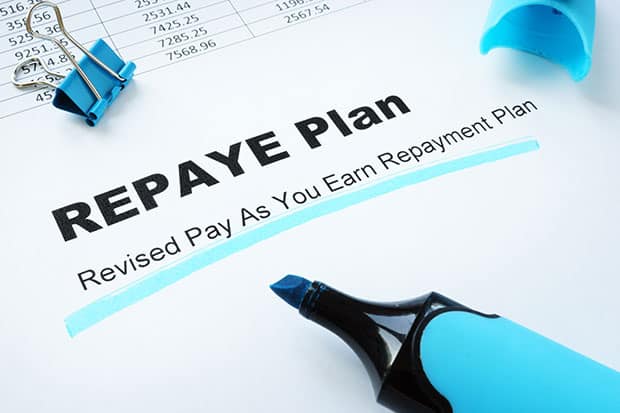
The repayment term is as follows:
- 20 years if all loans you’re repaying were part of an undergraduate degree
- 25 years if any of the loans you’re repaying were a part of a graduate or professional degree program
Any borrower with eligible federal student loans can make payments under this plan. To see what “eligible federal student loans” includes, go to the Department of Education’s web page on income-driven repayment plans.
Income-Contingent Repayment Program (ICR)
The Income-Contingent Repayment (ICR) program is open to any borrower with eligible federal student loans, with this caveat statement from the government:
“This plan is the only available income-driven repayment option for parent PLUS loan borrowers. Although PLUS loans made to parents can’t be repaid under any of the income-driven repayment plans (including the ICR Plan), parent borrowers may consolidate their Direct PLUS Loans or Federal PLUS Loans into a Direct Consolidation Loan and then repay the new consolidation loan under the ICR Plan (though not under any other income-driven plan).”
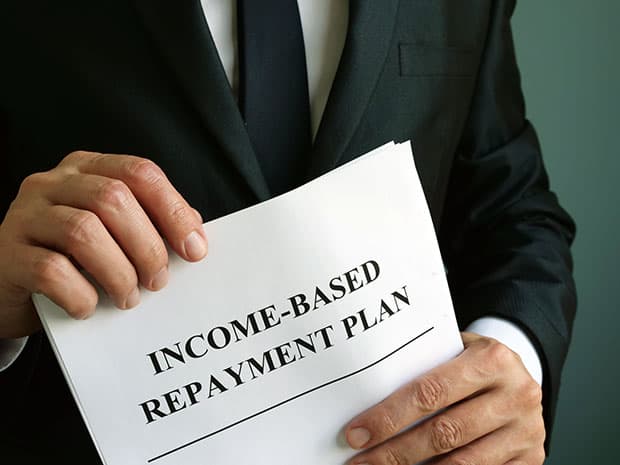
The ICR payment amount is the lesser of 20 percent of your discretionary income OR what you would pay on a fixed payment plan over the course of 12 years, adjusted based on your income.
The ICR payment term is 25 years before loan balances can be forgiven.
These guidelines encompass the basics of the four income-driven repayment plans. Here are a couple of other things you should know about income-driven repayment plans.
Other Information on Income-Driven Repayment Plans
Note that on all income-driven plans, hardship deferments and other periods of non-payment or zero dollar payment requirements typically DO count toward your required payment period.
Bonus: If you’re paying under an income-driven repayment plan and also working under the PSLF program, you might qualify for loan forgiveness after 10 years instead of 20 or 25 years. And your PSLF payments work with your income-driven plan repayments too. They don’t have to be separate term qualifiers like they do with some other programs.
The federal government student aid department has a loan simulator calculator to help you determine if you qualify for an income-driven repayment program--and what your potential loan payment amount might be.
Although the loan balances at the end of your repayment period are forgiven completely, there is something else you should keep in mind about loans that are forgiven.
Something To Remember About Forgiven Loans
Okay, let’s pretend that you’ve just learned through research that your student loans are eligible for student loan forgiveness. You’ve checked the facts and learned that part or all of your student loan balances can be forgiven.
What’s the catch?
Yes, there is a catch. And the catch is what’s commonly called the student loan forgiveness tax bomb. This means that you’ll be obligated to pay taxes on the amount of student loans you’ve had forgiven.
The student loan forgiveness tax bomb most commonly affects those whose loans are forgiven under the Income-Based Repayment (IBR) plan. Here’s how it works.
Under IBR rules, you have 20 to 25 years to repay your loans, based on your individual plan. If you don’t pay off your loans in full after the designated term, your loan balances are completely forgiven.
However, you will be required to pay an immediate tax on the loan amount that was forgiven. Note that this program is the most common program where people are hit with the tax bomb.
The following circumstances ensure you won’t get hit with a tax bomb when your loans are forgiven:
- Forgiveness programs tied to qualified employers, such as the PSLF and Teacher Loan Forgiveness
- Forgiveness programs involving Perkins Loans (see previous section)
- Death or disability of the primary loan holder (i.e. the student)
- Other forgiveness circumstances, such as if your school defrauded you or closed while you were a student
If, after researching your student loan forgiveness eligibility, did you find that you might be obligated to pay taxes on the forgiven amount? Your best bet is to save the money you’ll be required to pay before you apply for student loan forgiveness. That way you’ll avoid potential tax penalties if you can’t pay on time.
You can expect to pay taxes equal to your current tax rate on the forgiven amount.
No Student Loan Forgiveness For Private Student Loan Debt
There is one very important caveat you should know regarding student loan forgiveness. Only federal student loans are eligible to be considered for student loan forgiveness.
Private student loans are not eligible to be considered for student loan forgiveness. But if you read the next section, you might find a way to pay off your private student loans or federal loans that are ineligible for student loan forgiveness faster.
Can I File Bankruptcy On My Student Loans?
Unfortunately, it’s very rare to be able to get a judge to approve bankruptcy on student loans--especially federal student loans. If you can prove “undue hardship” due to the payments on the student loans, you may have a chance at getting approval for bankruptcy on them.
But know that this is pretty rare, and if you’re going to pursue this route, it’s smart to have a lawyer who is experienced in filing bankruptcies on student loans.
If You Can’t Get Your Loan Discharged, Consider Refinancing Or Consolidating Your Loans
If you’ve researched all potential student loan forgiveness options, and have found you don’t qualify for any of them, you still have the option to refinance or consolidate your student loans.
Depending on your current loan interest rates, refinancing or consolidating can save you hundreds or thousands of dollars. Here are a few companies you can check out if you want to learn more about refinancing your student loans.
Laurel Road
Laurel Road is a division of KeyBank and has been helping people get lower interest rates on student loans since 2013. They offer terms from five years to twenty years and have interest rates as low as 1.99% (with .25% autopay discount) as of this writing.
There are no origination fees or application fees with Laurel Road, and there’s no penalty for early payoff.
LendKey
LendKey has funded over $2 billion in student loans for customers. They’ve been helping customers with student loan refinance since 2009.
LendKey has interest rates of 1.90% as of this writing (with .25% autopay discount). There are no origination or application fees with LendKey, and no penalty for early payoff.
SoFi
SoFi has been helping people refinance student loans since 2011. They’re offering an interest rate of 2.31% (with .25 autopay discount) as of this writing.
Like the other companies mentioned here, SoFi has no origination fees or application fees. They don’t charge a penalty for early payoff either.
For more information on refinancing your student loans, check out our article on the 10 Best Places to Refinance Student Loans.
Company | Loan Types | Terms | Eligible Degrees | Rates |
|---|---|---|---|---|
Variable & Fixed | 5 to 25 | Undergrad & Graduate | ||
Variable & Fixed | 5, 7, 10, 15, 20 | Undergrad & Graduate | ||
Variable & Fixed | 5, 7, 10, 15, 20 | Undergrad & Graduate | ||
Variable & Fixed | 5, 7, 10, 15, 20 | Undergrad & Graduate | ||
Variable & Fixed | 5, 7, 10, 15, 20 | Undergrad & Graduate | ||
Variable & Fixed | 5 to 20 | Undergrad & Graduate | ||
Variable & Fixed | Varies by lender | Undergrad & Graduate | ||
Variable & Fixed | 5 to 20 | Undergrad & Graduate | ||
Variable & Fixed | Varies by lender | Undergrad & Graduate | ||
Variable & Fixed | 5 to 20 | Undergrad & Graduate |
There Are Lots Of Options For Student Loan Forgiveness
Student loans can cause quite a burden on your finances. Luckily, there are many ways you can potentially get your student loans forgiven.
And if you don’t qualify for student loan forgiveness, you can still find ways to get payments reduced or pay less interest by refinancing your student loans.
Readers, have you ever gotten student loans forgiven? We’d love to hear about your experience in the comments section.
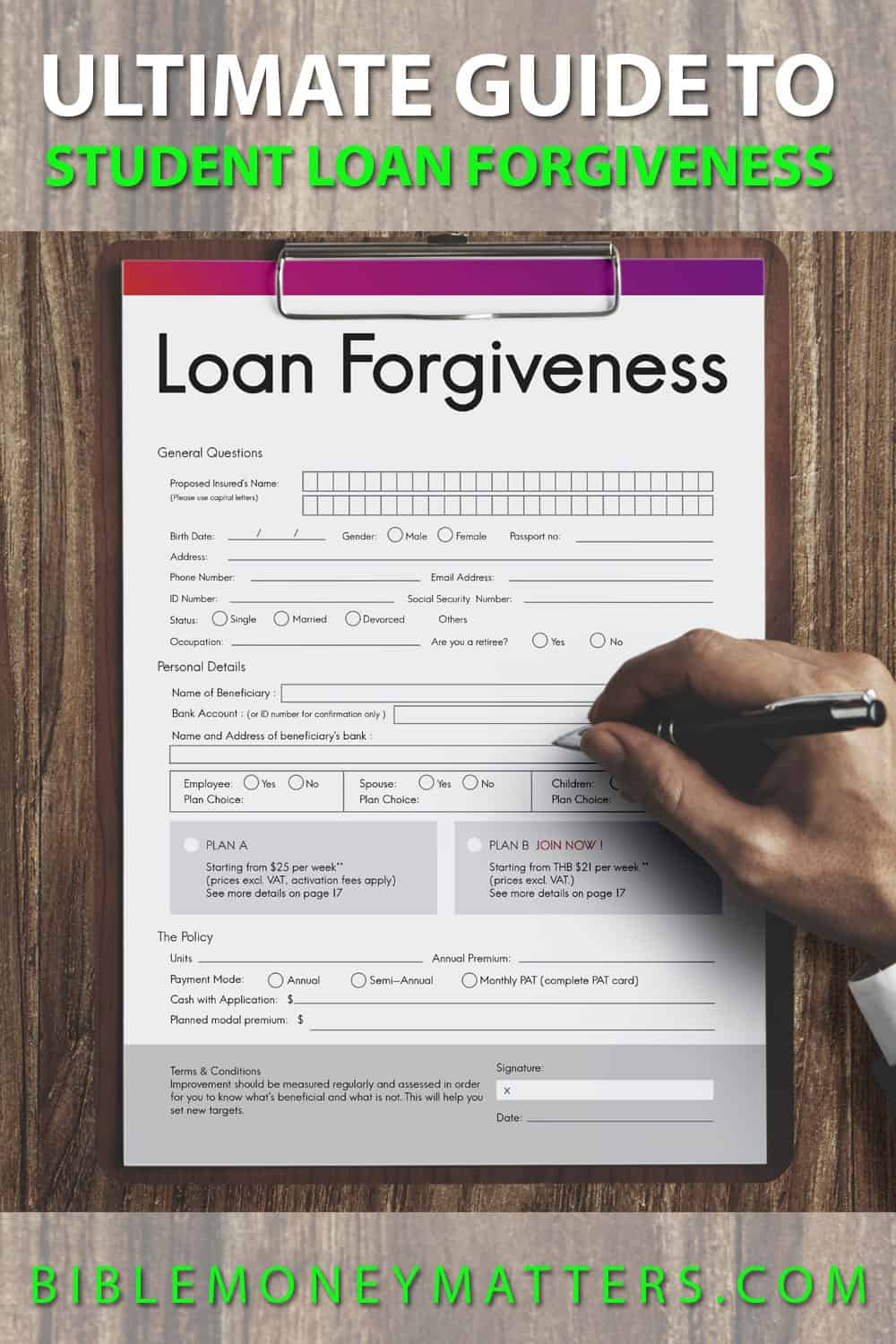




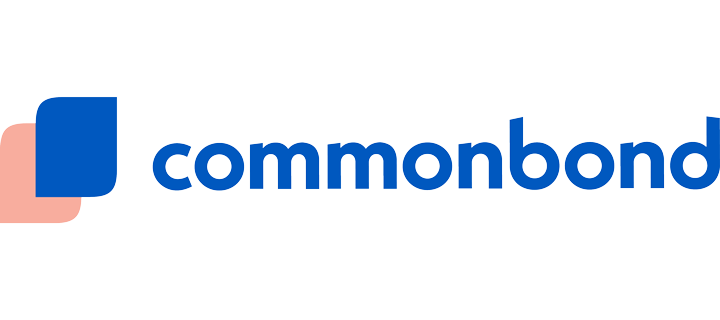






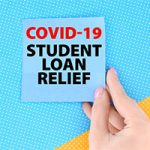
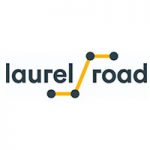
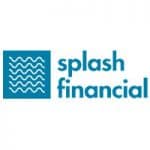

If you make a loan you need to pay it. If you don’t someone else will. I don’t expect my mortgage loan to be forgiven! Teach students to stop making big lists. Go to community colleges.